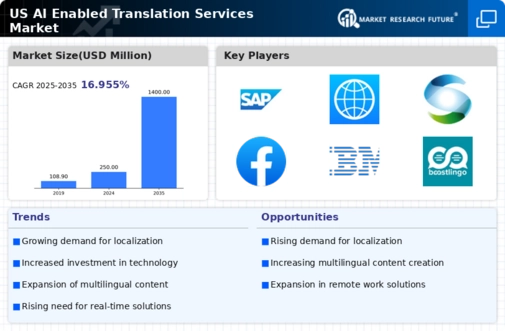Technological Advancements in AI
Technological advancements in artificial intelligence are significantly influencing the ai enabled-translation-services market. Innovations in machine learning and natural language processing are enhancing the accuracy and efficiency of translation services. For instance, recent developments have led to a 30% improvement in translation accuracy, making AI-driven solutions more appealing to businesses. These advancements allow for the processing of large volumes of text in various languages, catering to the needs of diverse industries. Furthermore, the integration of AI with existing translation tools is streamlining workflows, reducing turnaround times, and lowering costs. As organizations increasingly adopt these technologies, the ai enabled-translation-services market is likely to experience accelerated growth, with an estimated market value reaching $5 billion by 2026.
Rising Globalization of Businesses
The increasing globalization of businesses in the US is a primary driver for the ai enabled-translation-services market. As companies expand their operations internationally, the need for effective communication across diverse languages becomes paramount. This trend is reflected in the fact that over 70% of US companies are engaging in cross-border transactions, necessitating reliable translation services. The The AI-enabled Translation Services Market will benefit from this demand., as businesses seek to enhance their global reach and customer engagement. Moreover, the ability to provide accurate translations in real-time can significantly improve customer satisfaction and operational efficiency. As a result, the market is expected to witness substantial growth, with projections indicating a potential increase in market size by 25% over the next five years.
Growing E-Learning and Online Education
The expansion of e-learning and online education platforms is a notable driver for the ai enabled-translation-services market. With the rise of remote learning, educational institutions and organizations are increasingly offering courses in multiple languages to cater to a global audience. This shift is reflected in the fact that the online education market is projected to reach $350 billion by 2025, creating a substantial demand for translation services. The ai enabled-translation-services market is well-equipped to support this growth, providing tools that facilitate the translation of educational materials, course content, and assessments. As educational institutions strive to enhance accessibility and inclusivity, the demand for efficient and accurate translation services is likely to increase, further propelling market growth.
Increased Focus on Multilingual Content
The growing emphasis on multilingual content is a significant driver for the ai enabled-translation-services market. As businesses recognize the importance of reaching diverse audiences, the demand for high-quality translations is surging. Approximately 60% of consumers prefer to engage with content in their native language, prompting companies to invest in translation services. This trend is particularly evident in sectors such as e-commerce and digital marketing, where localized content can lead to higher conversion rates. The The AI-enabled Translation Services Market will cater to this demand., offering solutions that enable businesses to create and manage multilingual content efficiently. As a result, the market is projected to grow at a compound annual growth rate (CAGR) of 20% over the next few years.
Regulatory Compliance and Localization Needs
Regulatory compliance and localization needs are increasingly driving the ai enabled-translation-services market. Many industries, including healthcare and finance, are subject to strict regulations that require accurate translations of documents and communications. This necessity is underscored by the fact that non-compliance can result in significant penalties, prompting organizations to prioritize translation services. Additionally, as companies expand their operations into new markets, they must adapt their content to meet local cultural and legal standards. The ai enabled-translation-services market is likely to benefit from this trend, as businesses seek reliable solutions to ensure compliance and effective localization. The market is expected to see a growth trajectory, with an anticipated increase in demand for specialized translation services.

























Leave a Comment